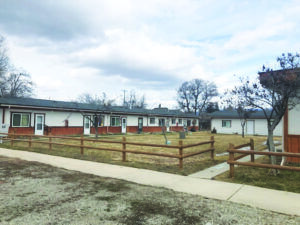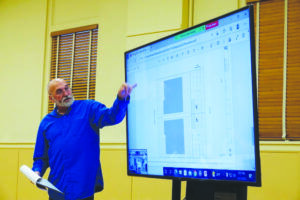
by Nathan Boddy
Several dozen people showed up to the Hamilton City Council meeting on Tuesday, March 21st where the hottest item on the agenda was a rezoning request by Ran Pigman of Pigmans Builders. The request, which was previously given a recommendation for approval by the city Zoning Commission, is to rezone the property at 210-214 South 8th Street from Single Family Residential (RS) to Residential High Density (RH). The property currently supports 10 dwellings, within three separate structures. According to Pigman, their intent would be to construct two, six-unit buildings and then sell both. City planner Mark Rud gave the staff presentation, detailing a point by point evaluation of the city’s criteria for consideration of rezoning requests. Based on those criteria, city planning staff recommended that City Council approve the rezoning.
In a very similar rezoning request last fall, Pigman Builders sought rezoning for a property on the northwest corner of North 5th and River. Also recommended for approval by city planning staff, that hearing drew a substantial amount of opposition from neighbors in the vicinity, and ultimately was rejected by the City Council. In his presentation about the current rezoning request, Ran Pigman mentioned the previous failed request on River, saying that Pigman Builders harbors no animosity toward those who were in opposition.

“We were simply trying to meet a perceived need while creating workload,” said Pigman. He also added, “We do feel that the River Street proposed plan was well within the allowances of the new growth plan, even within the perceived desires of it.”
One main point of divergence between the two proposals, however, is that the property on River Street had previously had a single family home upon it, while the 8th Street property already has high density housing.
Much of Pigman’s presentation centered around the recent adoption of the new Comprehensive Plan in the City of Hamilton. Within that plan substantial focus was given to the need for mixed housing types and integration of that housing into various regions within the city. Pigman echoed those sentiments with his personal observations, and added that the true need in Hamilton is for workforce housing, which he defined as, “people that are making a living wage but can no longer afford a single-family residence,” such as mechanics, nurses, tradesmen, and other key working members of the community. He also pointed out that the cost of housing ultimately means that new, single family homes often go to the highest bidder, which commonly means people from well beyond the area. As a counterpoint, he said that apartments mean less expensive, more readily available housing for families.
“We need to get away from thinking that apartment dwellers are second class citizens,” he said. “I do believe that most of us here lived in apartments before we could afford our first home.”
To bolster his point, Pigman said that his company had been in talks with both Bitterroot Health and Rocky Mountain Labs prior to the defeat of the rezoning request of River Street. Both entities had apparently expressed an interest in purchasing what would have been an 8-plex housing unit to house employees and their families.
During public comment, five members of the public spoke in opposition to the rezoning request, with concerns ranging from lack of green space to density and precedent for future infill developments. Their voices were added to the over 20 letters sent to city hall in opposition. A common point among nearly all the opposition is a stated concern over the potential to change what they perceive as the quiet nature of the neighborhood. Eric Sutherland said that he wanted to “tear the stuffing” out of several ideas, among them the notion that the adoption of the Comprehensive Plan represented the will of most residents. He suggested that if Hamilton would have clearly suggested a policy, “that invites densification,” that people would have rejected it out of hand.
Three people spoke in favor, including Mary Blankenbaker who said that she was in favor of an increase in the diversity of housing. “Just because I was lucky enough to get in when I bought my house doesn’t mean I should close the door behind me to all the other kinds of people that want to come and work here, play here and pay taxes here and contribute to the awesome character of our community,” said Blankenbaker.
Before their deliberation, Mayor Dominic Farrenkopf took a moment to express his appreciation at the civility of the proceedings.
“I am proud of this city,” he said. “Look at how many people we had come out to state their opinion and everybody was so respectful and let everyone talk. That alone is a win in my book.”
The Council voted unanimously to approve the rezoning request, but the matter will have one more hearing on April 4th at 7 p.m.

Star says
Will the folks that live in the present building on 8th be able to afford the projected new apartments? Where will they go? Is the proposal for low income housing or will there be more folks in Bitterroot Campground (probably illegal) ghetto??
Tim Abney says
If Pigman wants to build apartments they should buy property outside of the established neighborhoods in town so he isn’t encroaching on homeowners. The city council is more interested in building their tax base than considering existing residents’ desires.
GBJ says
These apartments aren’t owned by Pigmans. They’re owned by the property owner who hired Pigmans to build the apartments. This property already has 10 apartments on it.
Marie says
If the lab or hospital get a hold of them they’ll be used for travelers, not locals.